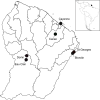Identification of French Guiana anopheline mosquitoes by MALDI-TOF MS profiling using protein signatures from two body parts
- PMID: 32817616
- PMCID: PMC7444543
- DOI: 10.1371/journal.pone.0234098
Identification of French Guiana anopheline mosquitoes by MALDI-TOF MS profiling using protein signatures from two body parts
Abstract
In French Guiana, the malaria, a parasitic infection transmitted by Anopheline mosquitoes, remains a disease of public health importance. To prevent malaria transmission, the main effective way remains Anopheles control. For an effective control, accurate Anopheles species identification is indispensable to distinguish malaria vectors from non-vectors. Although, morphological and molecular methods are largely used, an innovative tool, based on protein pattern comparisons, the Matrix Assisted Laser Desorption / Ionization Time-of-Flight Mass Spectrometry (MALDI-TOF MS) profiling, emerged this last decade for arthropod identification. However, the limited mosquito fauna diversity of reference MS spectra remains one of the main drawback for its large usage. The aim of the present study was then to create and to share reference MS spectra for the identification of French Guiana Anopheline species. A total of eight distinct Anopheles species, among which four are malaria vectors, were collected in 6 areas. To improve Anopheles identification, two body parts, legs and thoraxes, were independently submitted to MS for the creation of respective reference MS spectra database (DB). This study underlined that double checking by MS enhanced the Anopheles identification confidence and rate of reliable classification. The sharing of this reference MS spectra DB should make easier Anopheles species monitoring in endemic malaria area to help malaria vector control or elimination programs.
Conflict of interest statement
The authors declare that they have no competing interests.
Figures




Similar articles
-
Application of matrix-assisted laser desorption/ionization mass spectrometry to identify species of Neotropical Anopheles vectors of malaria.Malar J. 2019 Mar 22;18(1):95. doi: 10.1186/s12936-019-2723-0. Malar J. 2019. PMID: 30902057 Free PMC article.
-
New assessment of Anopheles vector species identification using MALDI-TOF MS.Malar J. 2021 Jan 9;20(1):33. doi: 10.1186/s12936-020-03557-2. Malar J. 2021. PMID: 33422056 Free PMC article.
-
Identification of Southeast Asian Anopheles mosquito species using MALDI-TOF mass spectrometry.PLoS One. 2024 Jul 5;19(7):e0305167. doi: 10.1371/journal.pone.0305167. eCollection 2024. PLoS One. 2024. PMID: 38968228 Free PMC article.
-
[Malaria, anopheles, the anti-malaria campaign in French Guyana: between dogmatism and judgment].Med Trop (Mars). 1997;57(4):401-6. Med Trop (Mars). 1997. PMID: 9612784 Review. French.
-
MALDI-TOF MS Profiling-Advances in Species Identification of Pests, Parasites, and Vectors.Front Cell Infect Microbiol. 2017 May 15;7:184. doi: 10.3389/fcimb.2017.00184. eCollection 2017. Front Cell Infect Microbiol. 2017. PMID: 28555175 Free PMC article. Review.
Cited by
-
Identification of Neotropical Culex Mosquitoes by MALDI-TOF MS Profiling.Trop Med Infect Dis. 2023 Mar 13;8(3):168. doi: 10.3390/tropicalmed8030168. Trop Med Infect Dis. 2023. PMID: 36977169 Free PMC article.
-
Identification of Southeast Asian Anopheles mosquito species with matrix-assisted laser desorption/ionization time-of-flight mass spectrometry using a cross-correlation approach.Parasit Vectors. 2025 Jan 16;18(1):8. doi: 10.1186/s13071-024-06655-1. Parasit Vectors. 2025. PMID: 39819789 Free PMC article.
-
MALDI-TOF MS: An effective tool for a global surveillance of dengue vector species.PLoS One. 2022 Oct 20;17(10):e0276488. doi: 10.1371/journal.pone.0276488. eCollection 2022. PLoS One. 2022. PMID: 36264911 Free PMC article.
-
[Malaria control in French Guiana: What are the challenges in this last endemic French territory in 2024?].Med Trop Sante Int. 2025 Mar 20;5(1):mtsi.v5i1.2025.536. doi: 10.48327/mtsi.v5i1.2025.536. eCollection 2025 Mar 31. Med Trop Sante Int. 2025. PMID: 40248577 Free PMC article. French.
-
Enhanced procedures for mosquito identification by MALDI-TOF MS.Parasit Vectors. 2022 Jun 30;15(1):240. doi: 10.1186/s13071-022-05361-0. Parasit Vectors. 2022. PMID: 35773735 Free PMC article.
References
-
- Ardillon V, Carvalho L, Prince C, Abboud P, Djossou F. Bilans 2013 et 2014 de la situation du paludisme en Guyane. Bull Veille Sanit. 2015;1: 16–20.
-
- Pommier de Santi V, Girod R, Mura M, Dia A, Briolant S, Djossou F, et al. Epidemiological and entomological studies of a malaria outbreak among French armed forces deployed at illegal gold mining sites reveal new aspects of the disease’s transmission in French Guiana. Malar J. 2016;15: 35 10.1186/s12936-016-1088-x - DOI - PMC - PubMed
Publication types
MeSH terms
LinkOut - more resources
Full Text Sources
Miscellaneous

